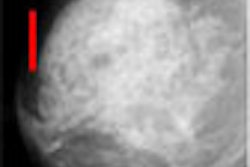This article is excerpted from Digital Mammography: A How-To Manual for Seamless Implementation by Valerie Andolina and Theresa Wade, HCPro, Marblehead, MA, 2006.
When establishing your digital mammography program, you'll need to create several new positions, whereas others will be phased out over time. You may need to add a PACS administrator and one or more information technology positions. Depending on your facility's volume and workflow, you may also need technologist assistants or coordinators to help with digital image hanging protocols and to smooth your processes.
At the Elizabeth Wende Breast Clinic (EWBC) in Rochester, NY, two temporary positions were added: one to digitize film images and one to sort through patient records each morning to determine which women would most benefit from a digital exam.
This was because the facility still had film equipment in addition to digital units and could not fully manage its population with the digital systems. If your facility makes the jump to digital all at once, the second additional position won't be necessary, because all patients will have their exams performed on a digital unit.
However, because connectivity and compatibility are still being resolved, you may need personnel to ensure that the correct priors are on the correct workstation so the radiologist will not have to waste time waiting for images to load. With the movement of the Integrating the Healthcare Enterprise (IHE) mammography working group, this type of situation likely will be short-lived.
Eventually you'll be able to cut back on darkroom assistants, radiology aides (both physician and technologist aides) who help hang films, chart room staff, potentially some of your technologists, and possibly transcription and billing personnel if these features become automated through your PACS/RIS.
When your system becomes fully electronic, one digital unit may be able to replace two film systems, decreasing the need for staffing and helping you increase your volume.
For the most part, staff at EWBC has eased into new positions as the facility made the transition to digital. For example, one technologist now spends a good portion of her day troubleshooting digital equipment, working with service people, and answering staff questions. Her title is now lead digital technologist.
Also, EWBC's PACS administrator is a staff member with a clinical background who showed an aptitude for computer technology. The clinic hasn't let any employees go yet, but may need to down the road as its processes solidify and it puts more digital units on the floor. At this time, EWBC is able to control the employee changes with the natural flow of turnover.
Staffing changes will be gradual when converting to digital technology. There is a long learning curve, and staff may initially take much longer to perform digital exams, making it unwise to cut back on staff until your digital workflow runs smoothly -- a process that can take months, or longer.
Although manufacturers may tell you that you'll be able to complete 40 or more mammograms per day on a single full-field digital mammography (FFDM) unit, it will definitely take time for you to reach that efficiency level. In the meantime, you may actually see a slowdown in productivity and need to cut back on your patient load until the staff are up to speed and all connectivity problems have been worked out among the vendors.
Initially, when EWBC converted to digital, it did so only on a limited basis. This course of action allowed the clinic to pick and choose the patients whose exams would be performed on the unit.
The facility offers same-day results to patients (70% of screening patients get their results while they are in the office, and 30% leave after their mammogram and are mailed the results), and initially performed screening mammograms on the digital units only for patients who did not want to receive their results that day. This allowed the physicians to spend more time interpreting the images and gain experience without interfering with workflow.
Only recently have the physicians begun using the units for diagnostic exams. These exams are generally more time-consuming and require specialized positioning and procedures that can sometimes tie up the FFDM unit and add complication to the electronic hanging procedure.
The longer you have the digital units in your facility, the more confidence your staff and physicians will have.
Choosing a PACS administrator
If you add a PACS, one of the most important positions you will need to fill will be for a PACS administrator.
There is much debate in the mammography world as well as in general radiography about who is most qualified for this position: a computer person or a clinical person. EWBC decided on a clinical person, who was then trained on technical issues.
The PACS administrator had been with the facility for seven years as a medical assistant. When the facility started to get involved with the American College of Radiology Imaging Network (ACRIN) study as a clinical-trial site, she received training on the soft-copy review workstations.
When EWBC installed its PACS, she was one of the nontechnologist staff to become a superuser. A superuser has greater in-depth training than other staff. She showed acumen for the digital technology, but also had a desire to learn and improve her skills.
Because a smooth electronic environment relies on understanding the clinical workflow, training her as a PACS administrator made sense. The PACS vendor provided most of her training, and she also attended several outside training sessions and seminars.
The rest she learned on the job. Having a noncomputer person train to be a PACS administrator can be a daunting process. But PACS vendors typically have help desks that your administrator can call for help with both technical and software-related problems.
If your PACS administrator has a technical background, that will be a bonus, but it's probably more important -- at least in EWBC's experience -- that he or she have a clinical background and know your current workflow.
The person in this position really needs to understand not only the organization's workflow, but also physician preferences and hanging protocols for the different exams and types of patients.
Qualifications
The PACS administrator should have solid people skills and must be able to work well with frustrated staff, physicians, and vendors.
He or she will be the liaison between clinical personnel and the service representatives and help desk, working with both to fix any problems that may arise.
This person should have an aptitude for computers, although a technical background is not necessary.
He or she can be brought up to speed on basic networking by attending educational seminars and by learning on the job.
By Valerie Andolina and Theresa Wade
AuntMinnie.com contributing writers
August 10, 2006
The "Mammography Regulation and Reimbursement Report" is a 12-page monthly newsletter designed specifically for mammographic technologists and supervisors that is published by HC Pro. The periodical offers ideas for better practice management from peers, billing tips, MQSA regulatory updates and guidance, and business ideas related to breast imaging. For a free trial subscription, please click here.
Related Reading
New study analyzes digital mammography's workflow impact, August 10, 2006
Take care when coding for digital mammography and CAD, July 13, 2006
Easing the pressure of compression for patients, June 27, 2006
Digital mammography: Can your facility afford to make the leap? May 11, 2006
MQSA reauthorization: What to expect and how to prepare, April 13, 2006
Copyright © 2006 HC Pro



















